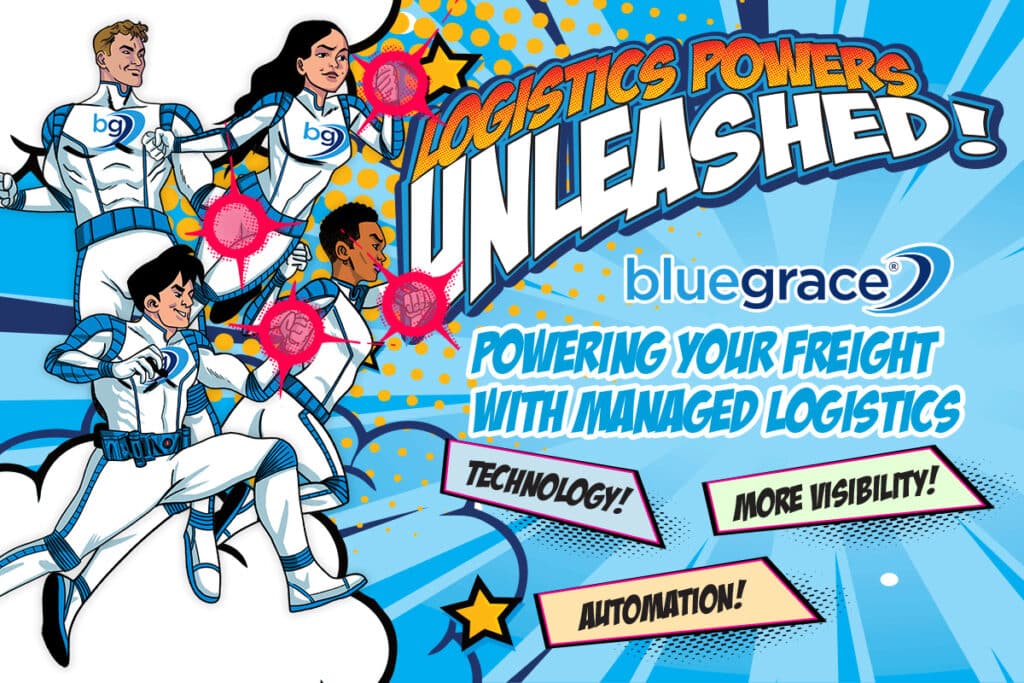The drayage industry has begun to come out of the shadows. Long “an uncelebrated hero,” according to Dana Ricksecker, general manager of drayage and intermodal for Florida-based BlueGrace Logistics, drayage’s place as “a cornerstone of the modern logistics landscape” is becoming widely recognized.
Drayage’s impact on the entire lifecycle of a shipment is pivotal
“Drayage’s impact on the entire lifecycle of a shipment is pivotal,” Ricksecker says. “Any errors or inefficiencies in this phase can have far-reaching consequences throughout the entire supply chain.
“Efficiently and accurately executing drayage is essential for the smooth flow of goods from their arrival at the port to their end destination,” she adds.
Drayage is “the connective tissue between U.S. ports and rail ramps,” notes Peter Weis, chief information officer and senior vice president of supply chain services for Nevada-based ITS Logistics.
“Drayage is a high-risk area because condensed activities happen in congested areas in a short amount of time,” Weis says. “Drayage is the first domino of the supply chain; if it doesn’t go right, it holds up everything down the line.”
As supply chain leaders better understand drayage’s importance, technology providers are developing sophisticated solutions that are transforming the industry’s traditional way of operating. The result is greater efficiency, improved service, and compelling new possibilities on the horizon.
A FRESH EMBRACE OF TECHNOLOGY
An assortment of critical challenges affect the drayage industry, such as capacity constraints, congestion and delays, compliance and regulations, maintenance and repairs, driver shortages, labor disruptions, appointment challenges, asset allocation and utilization, tight timelines, lack of visibility, outdated legacy software, and cost pressures.
“These challenges can impact the efficiency and profitability of drayage operations, making it difficult for carriers to compete in an underserved market,” says Michael Mecca, CEO and founder of PortPro, a Jersey City-based company that provides a drayage transportation management system.
When drayage companies use outdated technology, it can make those challenges that much more difficult.
“Drayage inefficiencies can be particularly challenging due to routing, manual paperwork, and communication issues,” Mecca explains. “These inefficiencies can lead to longer wait times, increased costs, and lower customer satisfaction.”
Before the pandemic-era supply chain disruptions, drayage historically had not seen much innovation. Among the factors holding the industry back was its skepticism of “flashy tech released by pure software providers,” Weis says.
“Drayage is an incredibly complex process, and businesses are hesitant to trust software providers that don’t offer hard-won ground operations experience,” Weis says.
Ricksecker agrees the drayage field has historically been slower to adopt technology than other segments of the supply chain, but the pandemic acted as a catalyst for digitalization across all sectors. The pandemic not only spotlighted drayage’s critical importance but also that it has been underserved by tech advances, leading to growing investor interest.
This new recognition has resulted in increased investment in technology solutions tailored to the drayage industry
“This new recognition has resulted in increased investment in technology solutions tailored to the drayage industry,” Ricksecker says, as has the persistence of legacy systems in many ports and logistics entities.
Outdated systems have become a hindrance as the complexity of supply chain operations has increased
“Outdated systems have become a hindrance as the complexity of supply chain operations has increased,” Ricksecker says. “Drayage companies are increasingly acknowledging the advantages of technology to optimize operations, streamline processes, and maintain competitiveness in the evolving logistics landscape.”
Array of Tech Solutions
A wide variety of tech advancements have led to notable improvements in drayage.
Technology empowers drayage carriers by providing the tools and capabilities necessary to enhance visibility, streamline operations, optimize planning, and effectively manage various aspects of their business
“Technology empowers drayage carriers by providing the tools and capabilities necessary to enhance visibility, streamline operations, optimize planning, and effectively manage various aspects of their business,” Ricksecker says. “These advancements contribute to greater efficiency, cost savings, and improved service quality in the drayage segment of the supply chain.”
Several different types of technology are helping to improve efficiency and streamline operations in the drayage field.
“Transportation management systems and electronic logging devices can help carriers to optimize routes, track shipments in real time, and reduce paperwork,” Mecca says. “Mobile apps and online portals make it easier for customers to track their shipments and communicate with drayage carriers.
“Cutting-edge integrations allow for the real-time bilateral sharing of information so cargo owners can be kept informed on status updates, document sharing, ETAs, and more,” he adds.
GPS elements located within the truck provide “more transparency to the last mile than there was before,” notes Mike Wilson, CEO of Consolidated Chassis Management, a New Jersey-based company that manages chassis on behalf of ocean carriers.
Enabling Transparency
“GPS can also provide data to the operating company to see where they’re being efficient and where they’re being inefficient or where there may be delays or other issues,” Wilson says. “The ability to have onboard monitoring systems, both for the truck and for the trailer, has helped make things safer and more efficient. It also provided more information to the carrier to better serve their clients.”
It’s simple: Customers want to know where their freight is.
“Drayage usually is the most complicated area to track because it works on the highway systems and you never know what’s going to happen,” Wilson says. “Delays, accidents, construction diversions—they all impede a truck’s ability to get to its destination.
“Transparency allows the shipper to see where their freight is, and then plan around that,” he adds. “Transparency is also important in terms of how data is accumulated and used. Transparency isn’t just being able to query a container, chassis, or trailer on the screen and see where it is. Data accumulates over time, and it provides valuable information for analytics down the road.”
automated tracking offers real-time visibility into container locations, minimizing errors
Similarly, “automated tracking offers real-time visibility into container locations, minimizing errors,” Ricksecker notes. “Simultaneously, live load tracking with geofencing facilitates better communication and coordination.
“Data-driven algorithms efficiently match imports with carrier empty acceptance,” she says. “This optimization of import loads and carrier empty acceptance, along with streamlined street-turning of containers, brings mutual benefits to both drayage carriers and customers. These practices result in cost savings by reducing empty container trips and improving asset utilization, leading to competitive rates for customers.
“Moreover, they decrease delays, ensuring prompt container availability and reducing the risk of detention fees,” Ricksecker says.
Artificial intelligence (AI) is leading the tech-based reshaping of the drayage industry.
AI plays a central role in streamlining operations, predicting congestion, optimizing traffic flow, analyzing sensor data for maintenance predictions, and improving route optimization, resource allocation, and the overall customer experience
“AI plays a central role in streamlining operations, predicting congestion, optimizing traffic flow, analyzing sensor data for maintenance predictions, and improving route optimization, resource allocation, and the overall customer experience,” Ricksecker says. “AI-driven software algorithms are revolutionizing load rate determination in drayage, reducing costs, and establishing more competitive drayage rates.”
ITS Logistics developed ContainerAI during the recent disruptive years. The solution uses AI to aggregate critical data points into a cloud-based platform with rail data, trucking milestones, ocean voyages, and port charges, among other information.
“AI allows us to sift through the available data to find the most trustworthy points, giving our customers intelligent conclusions,” Weis says.
The Rise of AI
“AI will become more relevant, with predictive and generative AI especially moving to the forefront,” Weis says. “Accurate and high-quality data must be the driver behind AI decision-making; otherwise, bad input equals bad output. Once the quality of data and business rules are defined, routine business decisions can be made autonomously.
“But that’s not to say that people and relationships won’t play a part,” Weiss adds. “The way forward is developing technology to improve relationships and empower people to their highest use.”
The possibilities of AI will only grow with time—and more data and users.
“Over time, as this data accumulates and we see increasingly more people comfortable with utilizing AI, these programs will be able to help companies be more efficient and drive out inefficiency—empty miles or equipment maintenance, for example—from the network that the drivers are operating,” Wilson says. “That will continue to evolve. We’re just at the beginning.”
Looking Ahead
Going forward, technology and innovation can help drayage operators transform their businesses and better navigate challenges facing the industry.
Through that effort, they can become better partners to other stakeholders in the supply chain, particularly as drayage firms progress from manual operations to using tech tools to improve decision-making and efficiency.
“Efficiency gains inside their own operations and their ability to run their businesses more effectively allow drayage operators to better serve their customers,” Mecca says.
When a drayage trucking company achieves operational efficiency and gains the capacity to offer comprehensive information and data to its customers, this translates into improved service overall.
And, enhanced operational performance across drayage companies contributes to compounding efficiency gains throughout the entire supply chain.
Technology and innovation are poised to drive a major transformation of the drayage field in the years ahead.
Revolutionary Changes
“The traditional methods of conducting drayage operations, which may have relied on manual processes and outdated systems, will increasingly be seen as slow, resource-intensive, and costly,” Ricksecker says.
“This transformation will affect various facets of drayage—including booking, scheduling, tracking, and reporting—with the goal of streamlining operations and enhancing customer service,” she says.
The drayage field can expect revolutionary changes that leverage technology to improve efficiency, sustainability, and customer experiences, ultimately reshaping the way goods move from point A to point B.
“Over the next five years,” Ricksecker adds, “the drayage field can expect revolutionary changes that leverage technology to improve efficiency, sustainability, and customer experiences, ultimately reshaping the way goods move from point A to point B.”





